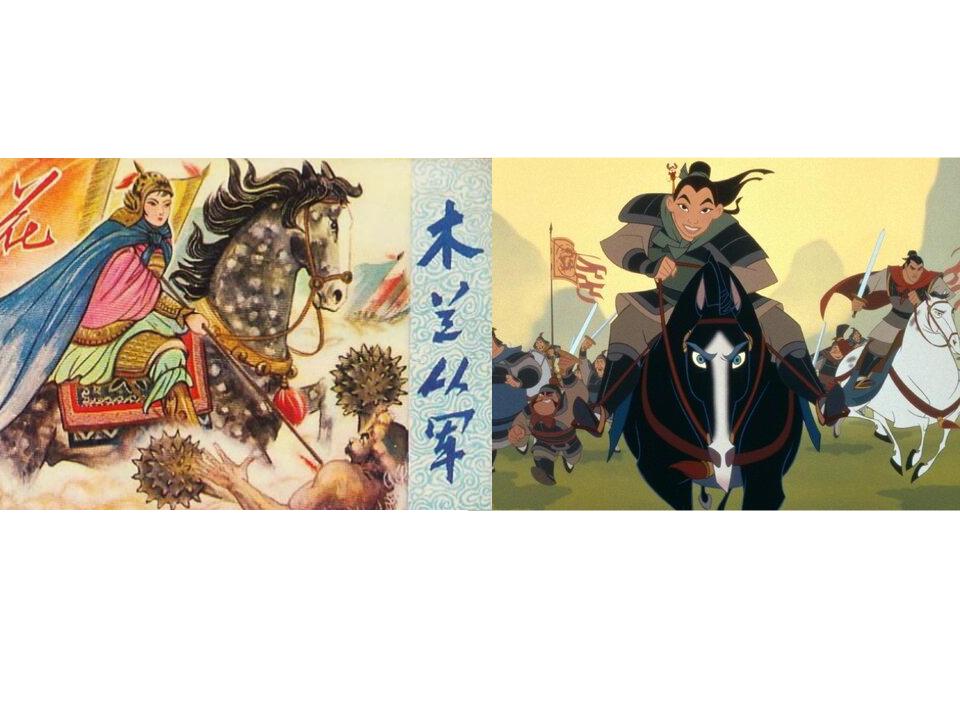Mulan represents the stereotype of the hesitant hero who has to strike a balance between commitment to her family and personal identity. She represents the coming together of traditional customs and contemporary ideals in Disney’s interpretations. She becomes a feminist icon who defies gender conventions by entering a male dominated field warfare to defend her family and nation because of her path of self-discovery and struggle against societal norms. While Mulan’s fundamental qualities, bravery, intelligence, resourcefulness and loyalty are thoughtfully constructed to conform to universal ideals, she is relevant to people from all walks of life. Her loyalty drives her actions to protect her family, her brilliance helps her become a strong warrior, and her fearlessness enables her to question the established gender roles. In China, these qualities are traditionally significant as symbols of filial piety and devotion. In the West, they symbolize individual strength and autonomy.
Mulan defies several stereotypes, most notably the idea of the submissive domesticated woman. Eastern cultural female figures are typically portrayed as subservient or limited to household duties by posing as a man displaying physical prowess. And rising to prominence as a leader, Mulan changes this. Mulan’s betrayal places more emphasis on her morals intelligence and fighting skills than on unconventional female warrior tropes that highlight beauty or romantic interests this changes the focus from a gender-based role to one that is more inclusive, and ability focused. Mulan’s tale encourages viewers, especially young girls, to believe that they are capable of overcoming social standards and promoted expectations of gender equality and empowerment. Her story implies that modern women can pursue historically male-dominate roles without compromising cultural values or femininity by demonstrating that women can achieve a balance between family loyalty and a strong sense of self. Even in environments that have historically been dominated by men, many people look to this character as an inspiration for more gender equity and opportunity.
Mulan’s character can have both positive and negative impacts. Positively, she encourages viewers to value boldness and self-worth over appearance by promoting independence, perseverance and self-confidence. However, some people may experience internal struggle because of her character’s hybridization, particularly those who are juggling different cultural standards. Viewers may feel pressured to replicate both Eastern familial loyalty and Western independence because they do not entirely belong to either set of ideals, which can lead to conflict. Nonetheless, Mulan’s representation as a complex, capable heroine generally has a positive, inspiring impact on viewers’ perceptions of themselves. Mulan’s influence on culture reflects a wider conversation about Asian character portrayal as well as a growing acceptance of strong female leads in the media. Her persona has received recognition for defying Hollywood’s long-standing propensity to limit Asian and female parts to cliches. There is, nevertheless, considerable criticism, especially from conservative viewers who believe that some fundamental Chinese values have been watered down or misrepresented to appeal to Western audiences. Mulan’s (2020) depiction of “chi” as a magical power or “cultural deconstruction is also shown through the failure of Mulan’s arranged marriage as a daughter in her family” (Tendenan, 2024), for example, were attacked for oversimplifying or even twisting cultural values to suit Western story patterns.


Berea Woldeyes
In the analysis of Mulan “Folklore to Fairytale”, the writer did a phenomenal job at descriptively presenting the differences between Mulan and gender conventions. As written in the analysis, the writer did an amazing job at highlighting how Mulan becomes a feminist icon in our society and goes against the stereotypical gender norms placed on women. Often in eastern culture there is a particular representation of female roles, as the writer described, which includes “household duties” and “submissive domesticated women”. The writer however didn’t contrast two different characters, rather the clash between Mulan and typical feminine roles in western films.
The writer’s main points included:
1. Mulan defies traditional customs through taking on the role of a hero (often played by males).
2. Mulan represents qualities that are not often represented in western culture for women like physicality and moral intelligence.
3. The positive impact of Mulan is the representation of Asian characters in Disney and promotion of independence and self-confidence for women.
4. The negative impacts of Mulan could be the complexity of her character leaving the audience experiencing a potential internal struggle.
I think the writer of the analysis lacked several scholarly sources. From reading over the post only one source seemed to be mentioned and a bibliography was also missing. Something I think the post also may have missed as well was an explanation for images that were chosen for this analysis (the two different ones and their significance). Overall, because I have personally watched Mulan, I understood the analysis from the two photos that were shared, however, maybe for an audience that have never seen the movie explaining the photos could have been helpful. Especially the one on the left that was not taken from the film.